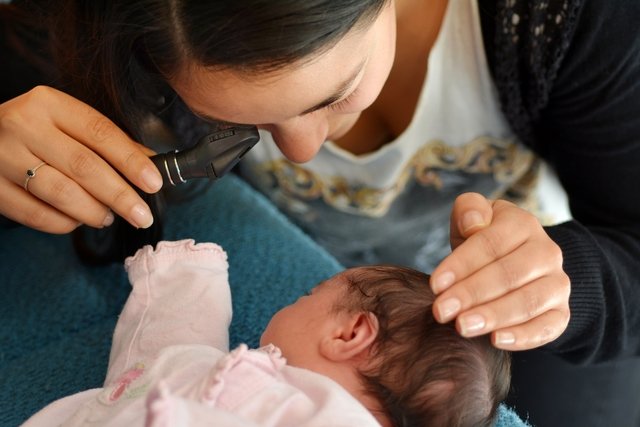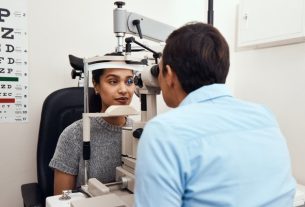Congenital cataract is the clouding of the natural lens of the eye, called the crystalline lens, resulting in symptoms such as a white or gray spot in the pupil, which is in the center of the eye, or the absence of a red reflection in the eye when taking a photo, for example, and can affect one or both eyes.
Congenital cataracts are present in the baby from birth, being caused by infections in women during pregnancy, such as toxoplasmosis or rubella, or by metabolic diseases or malformations in the baby’s eyes.
Read too: Cataract: what it is, symptoms, causes, types and treatment
The treatment of congenital cataracts in babies is carried out by an ophthalmologist and generally involves a simple surgery that replaces the lens in the baby’s eye.

Symptoms of congenital cataract
The main symptoms of congenital cataracts are:
- White or gray spot in the pupil, which is in the center of the eye;
- Absence of red reflection in the eye when taking a photo;
- Abnormal eye movements, called nystagmus;
- Child appears not to be attentive or aware of the world around him.
Congenital cataracts are present from birth and can affect one or both eyes. In some cases, this spot on the pupil may also develop and worsen over time.
When a congenital cataract is suspected, it is important to take the baby to the pediatrician, as this will help identify the cataract and refer the child to an ophthalmologist for appropriate treatment.
How to confirm the diagnosis
The diagnosis of childhood congenital cataracts can be made shortly after birth by a neonatologist or pediatrician in childhood when evaluating the baby or child’s eyes and performing the eye test. See how the eye test is done.
To confirm the diagnosis of congenital cataracts, the doctor must perform a red reflex exam, also known as the eye test, in which a special light is projected onto the baby’s eye to observe whether there are changes in the structures.
If a cataract is identified, follow-up should be carried out by an ophthalmologist who can indicate the most appropriate treatment.
Make an appointment with an ophthalmologist in the region closest to you:
Taking care of your health has never been easier!
Possible causes
The main causes of congenital cataracts are:
- Family history of cataracts;
- Infections in women during pregnancy, such as toxoplasmosis, rubella, herpes or cytomegalovirus;
- Abnormalities in the development of the baby’s eyes during pregnancy;
- Metabolic disorders such as galactosemia, diabetes or hypoglycemia;
- Syndromes, such as Down, Patau or Edward syndrome.
Furthermore, congenital cataracts can also be caused by injuries or trauma to the eyes after birth.
However, most congenital cataracts do not have a specific cause and are classified as idiopathic.
How the treatment is carried out
The treatment of congenital cataracts must be carried out under the guidance of an ophthalmologist and depends on the severity of the disease, the degree of vision and the age of the baby.
In general, the doctor should recommend intraocular lens placement surgery to replace the eye’s natural lens, called the crystalline lens, which should be performed between 6 weeks of age and 3 months. However, this time may vary depending on the doctor and the child’s history.
Read too: Cataract surgery: who does it, how it is done, recovery and risks
Generally, the surgery is carried out in one eye under local anesthesia and after 1 month it is carried out in the other, and during recovery it is necessary to apply some eye drops recommended by the ophthalmologist, to alleviate the baby’s discomfort and also prevent the emergence of an infection.
In cases of partial congenital cataract, the use of medication or eye drops may be indicated instead of surgery.
Bibliography
- LAGRÈZE, W. A. Treatment of congenital and early childhood cataract. Ophthalmologe. 118. Suppl 2; 135-144, 2021
- AL-DAMRI, A.; ALOTAIBI, H.M Congenital Cataracts in Preterm Infants: A Review. Cureus. 15.6; e40378, 2023
- GUPTA, P.; PATEL, B. C. IN: STATPEARLS (INTERNET). TREASURE ISLAND (FL): STATPEARLS PUBLISHING. Pediatric Cataract. 2023. Available at: <https://www.ncbi.nlm.nih.gov/books/NBK572080/>. Accessed on February 5, 2024
- TAYLAN SEKEROGLU, H.; UTINE, G.E. Congenital Cataract and Its Genetics: The Era of Next-Generation Sequencing. Turk J Ophthalmol. 51. 2; 107-113, 2021
- PEREIRA, Maria Luciana C.; NEVES, Rejanne C.; BATISTA, Leonardo. Early diagnosis of congenital cataract by ophthalmological evaluation in newborn patients.

Sign up for our newsletter and stay up to date with exclusive news
that can transform your routine!
Warning: Undefined array key "title" in /home/storelat/public_html/wp-content/plugins/link-whisper-premium/templates/frontend/related-posts.php on line 12
Warning: Undefined array key "title_tag" in /home/storelat/public_html/wp-content/plugins/link-whisper-premium/templates/frontend/related-posts.php on line 13



